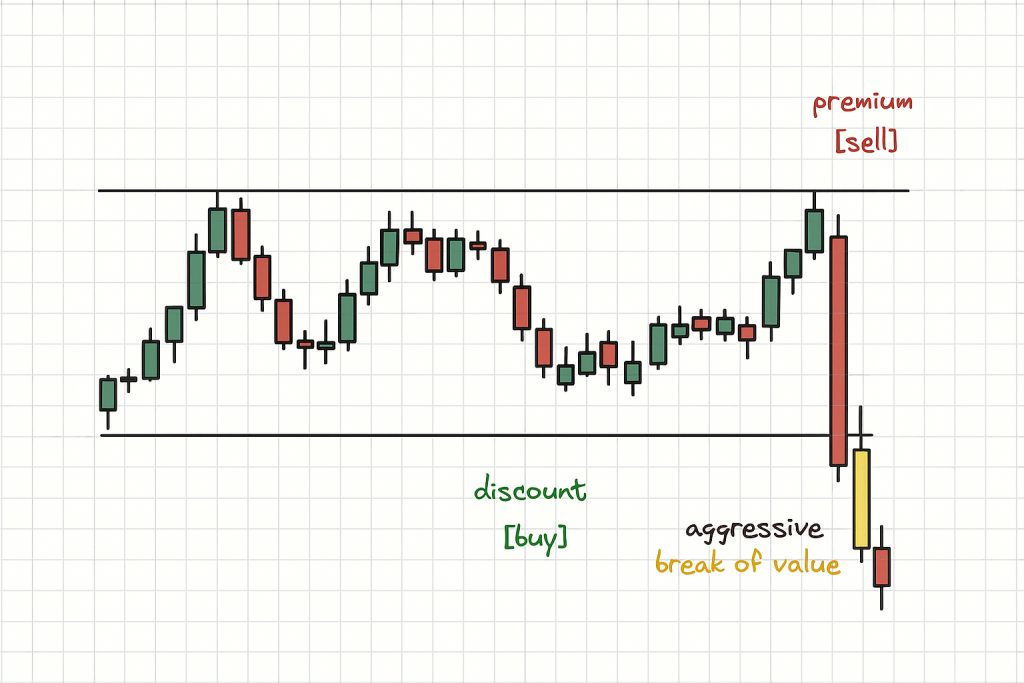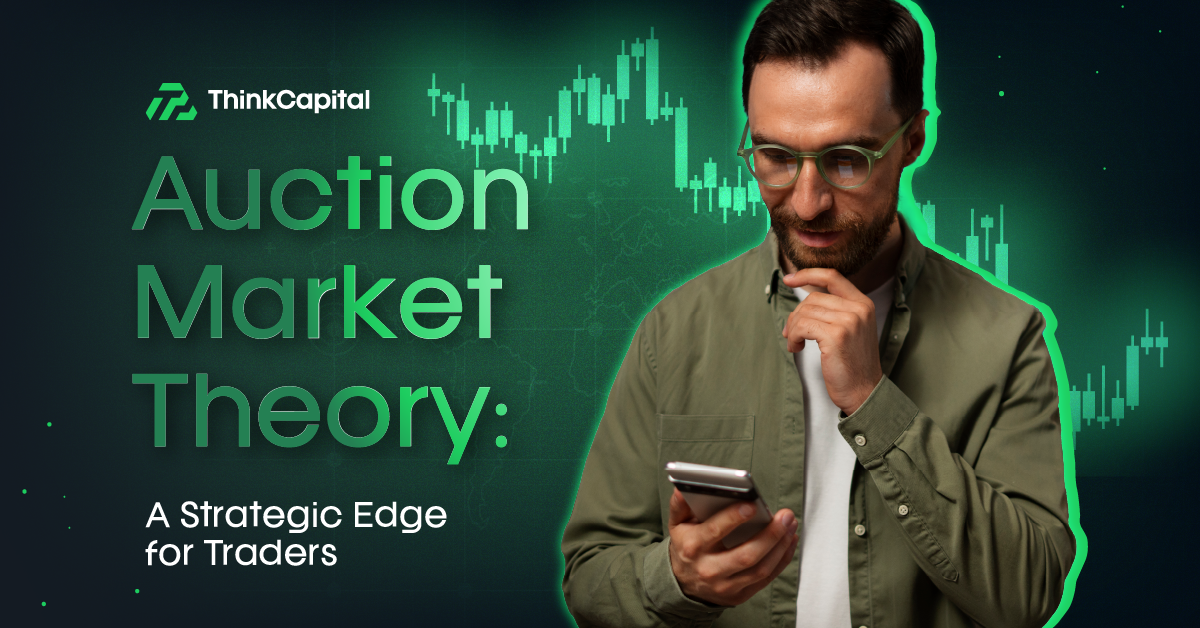When traders talk about developing a profitable trading strategy, they often focus on technical indicators or fundamental analysis. One powerful framework, auction market theory (AMT), often flies under the radar. Yet it lies at the core of how price discovery really happens in financial markets.
Whether you’re into day trading, discretionary trading, or using automated trading systems, understanding how an auction market works can help you spot price imbalances, improve your trading decisions, and gain a deeper understanding of market structure.
What Is Auction Market Theory?
At its core, auction market theory is a way of viewing the market as a dynamic auction where buyers submit bids, sellers submit offers, and price moves to the point where supply meets demand. This interaction forms the fair value, or the fair price, of a financial instrument.
Unlike other technical trading strategies, AMT doesn’t just focus on price levels. It also focuses on volume data, trading session behavior, and how market participants interact over time. This makes it an incredibly valuable tool for traders aiming to understand market dynamics more deeply.
The Role of Market Participants in Price Discovery
Think of every trade as a small vote on what the current value of an asset should be. Large institutional players, broker dealers, and smart money traders often influence the market more heavily, but retail traders, too, play a role in creating price moves.
The push and pull between buyer and seller aggression causes imbalances that result in movement toward higher or lower prices. This process is called price discovery, and it’s the beating heart of auction market theory.
In balanced markets, where buying and selling are relatively equal, price stays within a range. But when imbalances occur, such as a surge in buy or sell orders, the market breaks out of that range and forms new value areas.

Understanding Volume Profile and Market Structure

The volume profile is a key concept within AMT. It shows how much trading occurred at each price level during a given time frame. From this, traders can spot high volume nodes (HVNs), where trading clustered heavily, and low volume nodes (LVNs), where trading was light.
- High volume nodes often indicate strong price acceptance.
- Low volume nodes can hint at future price breaks or potential reversals due to weak conviction.
These areas help define the market profile, and when used alongside technical indicators, they reveal key features of market behavior that would otherwise go unnoticed.
From Initial Balance to Selling Tails: Price Behavior Patterns
One of the earliest signals during a trading session is the initial balance, which is the range of prices established during the first hour or so. It often sets the tone for the day.
A breakout beyond this range can lead to significant price expansion, while a failure to break out may indicate balanced market conditions. Patterns like the selling tail (a quick rejection from higher prices) and buying tail are subtle yet powerful clues into market sentiment.
When price discovers a new range due to market events or fundamental analysis shifts, traders who understand AMT are better positioned to capitalize.

Auction Market Theory in Day Trading and Other Strategies
Many technical traders find AMT useful for short-term tactics like day trading or scalping, where reading market movements quickly is essential. Others use it to inform trading ratios or guide discretionary trading decisions.
It also plays a major role in automated trading, where advanced computer modeling techniques use AMT principles to build algorithms that trade based on volume analysis, price levels, and market inefficiencies.
No matter the style, incorporating auction theory into your trading plan improves both entry and exit strategies, especially when coupled with an understanding of demand dynamics, risk tolerance, and even tax implications.
Why Most Trading Strategies Benefit from Auction Insights
While many traders rely solely on technical trading or fundamental trading strategies, combining them with AMT can offer an edge. For instance:
- Technical analysis shows patterns, but AMT reveals the strength behind those patterns.
- Fundamental analysis shows why a price should move; AMT shows if the market agrees.
By blending the auction market theory with your existing system, you’re not just reacting to price. You’re understanding the why behind the move.
Spotting Smart Money and Anticipating Market Events
Large financial instruments often behave differently when smart money is at play. AMT-trained eyes can detect these subtle shifts, particularly during market events or abnormal market conditions.
Whether you’re seeing volume spikes, sudden seller aggression, or changes in market orders, these are not just noise. They’re signs of market inefficiencies that can be used to your advantage.
The Future of Auction Market Theory in Trading
As financial markets evolve, so does the way traders engage with them. Today’s platforms offer integrated volume profiles, automated analysis tools, and seamless access to price data, making AMT more accessible than ever.
For tor traders at ThinkCapital, AMT is more than theory. It’s part of how traders reach higher prices, make smarter trading decisions, and ultimately see revenue growth.
Whether you’re aiming to buy or sell, AMT gives structure to what can otherwise feel like chaos.
Final Thoughts: Why Auction Market Theory Matters
In a world of flashy indicators and overcomplicated systems, auction market theory brings traders back to the basics: understanding how real people (and algorithms) interact in an auction-style marketplace.
By mastering this framework, traders unlock a deeper awareness of market behavior, price movements, and the forces shaping every candlestick on their screen.
And for those at ThinkCapital, it’s not just about theory. It’s about using smart tools, data-driven insights, and the strength of a broker-backed prop firm to gain an edge in the ever-evolving world of trading.
Ready to apply Auction Market Theory to your next challenge?
Trade with ThinkCapital, where data meets strategy and smart money gets to work.

Frequently Asked Questions
Q: What is the basic auction theory?
A: Basic auction theory explains how prices are formed in a competitive market through the interaction of buyers and sellers. In trading, this theory suggests that price moves to the point where supply meets demand, known as fair value. When there’s more buyer aggression than seller aggression (or vice versa), the price discovers a new level, which is the foundation of auction market theory used in modern trading strategies.
Q: What is the auction theory of the market profile?
A: The auction theory of the market profile refers to how traders use volume profile and market profile charts to visualize the auction process in financial markets. These tools highlight high volume nodes, low volume nodes, and the value area. This makes it easier to identify balanced markets, price acceptance, and areas where imbalances occur. It helps technical traders make better trading decisions by showing where most of the buying and selling has occurred during a trading session.
Q: What is the auction market model?
A: The auction market model is a framework used in technical analysis that treats price movement as a continuous auction between buyers and sellers. It emphasizes concepts like price discovery, initial balance, and volume analysis to predict market movements. The model is especially useful for day trading, discretionary trading, and developing technical trading strategies based on real-time market behavior.
Q: What is the auction theory in economics?
A: In economics, auction theory studies how various auction formats (e.g., English, Dutch, sealed-bid) determine the outcome of buying and selling goods or services. In trading, this theory is adapted to the financial markets, where it explains how prices form based on buy and sell orders, market sentiment, and market participants’ decisions. This crossover from economics to trading makes auction theory a valuable tool for understanding price levels, fair price, and market inefficiencies.
Q: What is the best trading strategy?
A: There is no single “best” trading strategy. It depends on your goals, risk tolerance, and trading style. However, the most effective traders often combine technical trading strategies, fundamental trading strategies, and frameworks like auction market theory to create a well-rounded approach. Strategies that account for market conditions, use volume profile data, and adapt to market structure shifts tend to outperform rigid, one-size-fits-all systems.

Disclaimer
Trading involves high risk, and retail investor accounts can lose money rapidly due to leverage. This article is for educational purposes only. It should not be considered financial advice. Always do your own research and consider your financial situation before making any investment decisions. Effective risk management is essential in Forex trading to protect your capital and manage risk appropriately.








